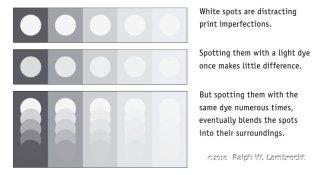Marco B
Subscriber
Hi all,
Spotting prints is not really my fortitude, and I generally try to keep my negatives as clean as possible, but recently I had a roll that I somehow managed to damage (still haven't figured out exactly where it went wrong), and that required spotting for a couple of prints.
Now I did manage to get some acceptable results, but also ditched two prints as I accidentally added to much Spotone ink (some old stock I still had) on the paper, which proved difficult to remove. I did notice the ink was slightly water soluble again by using a wet brush, but was unable to remove the ink properly using some absorbent paper, so I ditched the prints.
After that, a bit late, I started wondering if there is a good way to remove retouches of Spotone ink or comparable products and inks from fibre based papers :confused:
I found one link suggesting a dilute solution of simple plain ammonia:
http://photo.net/black-and-white-photo-printing-finishing-forum/006PyU
Have others ever used such method for removing Spotone retouches gone wrong? Any success or other suggestions for successfully rescuing a (fibre based) print with to much retouching ink?
Please: no suggestions for spotting itself: there are enough sources on APUG and the tips in the above link for that, I am interested in the removal part of the question...
Marco
Spotting prints is not really my fortitude, and I generally try to keep my negatives as clean as possible, but recently I had a roll that I somehow managed to damage (still haven't figured out exactly where it went wrong), and that required spotting for a couple of prints.
Now I did manage to get some acceptable results, but also ditched two prints as I accidentally added to much Spotone ink (some old stock I still had) on the paper, which proved difficult to remove. I did notice the ink was slightly water soluble again by using a wet brush, but was unable to remove the ink properly using some absorbent paper, so I ditched the prints.
After that, a bit late, I started wondering if there is a good way to remove retouches of Spotone ink or comparable products and inks from fibre based papers :confused:
I found one link suggesting a dilute solution of simple plain ammonia:
http://photo.net/black-and-white-photo-printing-finishing-forum/006PyU
Have others ever used such method for removing Spotone retouches gone wrong? Any success or other suggestions for successfully rescuing a (fibre based) print with to much retouching ink?
Please: no suggestions for spotting itself: there are enough sources on APUG and the tips in the above link for that, I am interested in the removal part of the question...
Marco








 but don't hthe instructions suggest Sodium Bicarbonate solution ?
but don't hthe instructions suggest Sodium Bicarbonate solution ?



